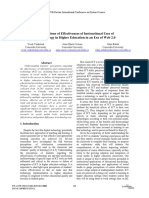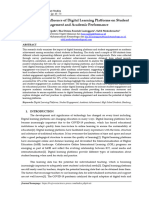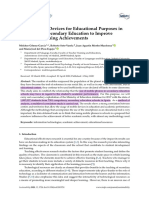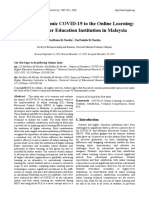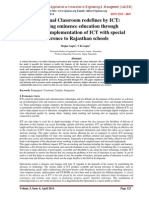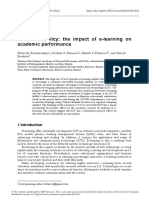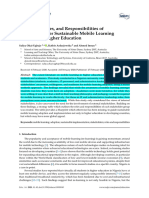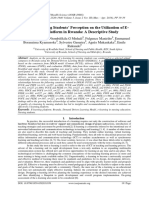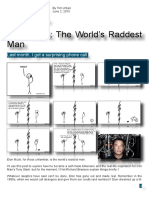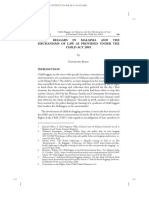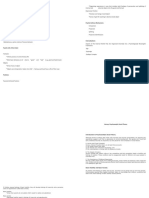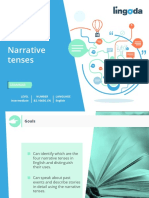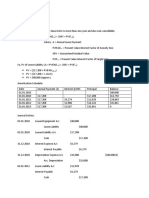Perceptions of Effectiveness of Instructional Uses of Technology in Higher Education in an Era of Web 2.0
Vivek Venkatesh Concordia University vivek.venkatesh@concordia.ca Anne-Marie Croteau Concordia University anne-marie.croteau@concordia.ca Jihan Rabah Concordia University jihan.rabah@education.concordia.ca
Abstract
Understanding learners’ perceptions regarding the effectiveness of information and communication technology (ICT) use, including those in the broad category of social media, is both important and critical to the success or failure of integration of ICT in higher education settings. Using theories of educational psychology and technology integration, a 50-item survey was constructed and data were collected from 14,283 students from 12 Québec universities in Canada, using a probabilistic sampling strategy. Exploratory factor analyses followed by multiple regressions show that engaging lectures, effective use of ICT tools for individual study and group-work, as well as active and self-regulated study strategies have a positive and significant impact on students’ perceptions of course effectiveness. Results are discussed in light of research on social media tools, instructional effectiveness and gender difference in technology use.
1. Introduction
Despite the fact that digital technology potentially facilitates new approaches of teaching and learning, it cannot guarantee per se that effective and appropriate learning outcomes are achieved [1]. Several researchers have investigated the link between perceptions of information communication technologies (ICTs) used in the classroom and students’ quality of learning [2,3,4,5]. Understanding the perceptions of students regarding the effectiveness of technology use and their proficiency and knowledge of specific types of ICT tools are both influential and critical to the success or failure of integration of ICT in higher education settings. It is important to shed light upon perceptions of students’ course effectiveness so that we make sure that technology implementation in higher education settings is congruent to better educational quality and increase in student gains. How much ICT is to be used in academic learning situations may play a less a clear-cut role. A survey of 800 mid-west undergraduate students with regards to their ICT skills, perceived educational benefits and teachers’ effectiveness indicated that students’ perceived ICT competency, whether for personal or instructional activities did not strongly predict perceived ICT benefits [6]. In addition, there was a negative link observed between perceived faculty integration of ICT and students’ perceived learning benefits [6]. The analysis of responses from this stratified random sample appear to suggest that the more a technology is used by a professor, the less students feel it might enhance their learning. It seems that when students perceive themselves as competent in their use of ICT in general, they attribute the beneficial effects of ICT to their own learning [7]. They integrate in their studies several types of ICT tools, depending on the goal of the activity at hand, selecting and appropriating technologies according to their own personal needs, whilst being aware of the benefits and shortcomings of each tool. Students’ decision to use technology is proportional to the time invested in learning to use that technology and its perceived benefit to them [1]. Given the complexity of better understanding the role of ICT in students’ learning experiences and the fact they employ several strategies inside and outside the classroom to complete their learning, we propose an exploratory study that will enhance the comprehension of the factors impacting students’ perceptions of course effectiveness, especially as they relate to the growing adoption and integration of social media in higher education classrooms. Our study is unique in that it adopts theories grounded in instructional applications of educational psychology, instructional technology and applications of social media to gauge perceptions of course effectiveness across a large sample of undergraduate students. ICT tools are perceived as being very useful to learning in higher education settings when students realize that they will be using them at work settings later on [8].
2014 47th Hawaii International Conference on System Science
978-1-4799-2504-9/14 $31.00 © 2014 IEEEDOI 10.1109/HICSS.2014.22110

Indeed, students demonstrate a greater inclination to use ICT tools if they know they will use them in nonacademic settings as well. At university level, students start becoming aware of the benefits that ICT offers them, not only to pass their coursework but also, for their survival in the current complex and multifaceted work settings [8]. The specific objectives of this paper are to: 1.
explore the relationships between perceived use of different types of ICTs, including those of social media, and their perceived efficacies of use; 2.
explain how perceived course effectiveness can be linked to perceptions of instructional methods employed by teachers and studying approaches adopted by learners. This paper explores results from a large-scale survey of Québec university classrooms to paint a picture of how undergraduate students’ perceptions of effectiveness of instructional approaches and ICT use impacts their perceptions of the quality of the courses offered. We hope our paper can contribute a social-science and educational technology-based approach to the broader discussion of how higher education classrooms are adapting to the use of modern Web 2.0 tools, as well as whether there is an alignment between students’ perceptions of their learning needs and their perceptions of their instructors’ pedagogical approaches.
2. ICT in Higher Education Settings
The burgeoning integration of ICT in higher education has reached a tipping point. While it may be a challenge to find academic institutions that pay no heed whatsoever to the affordances of ICT, the differential manner and extent to which its integration occurs may have significant implications for students' perceptions of course effectiveness. ICT tools are constantly evolving and developing [9]. Universities are, therefore, not surprisingly, investing in ICT tools to meet the technological demands of today’s world [10]. We are witnessing a growing trend of increasingly sophisticated ICT tools in education. As such, these may herald the telltale signs of the future indispensability of ICT tools to the educational sector. To explore the role of ICT in higher education settings, we have reviewed various critical aspects of students’ learning experiences, including their knowledge of ICT, the teaching methods they are exposed to, their adoption of different learning strategies, the way they cognitively and metacognitively regulate their learning, and their perception of the benefits of ICT used inside and outside the classroom. These five independent factors are now introduced and will be used in our analyses to predict students’ perceived course effectiveness.
2.1. Knowledge of ICT
The use of ICT renders information more easily accessible, decentralized, free, boundless place and time [11]. In addition, certain ICT tools can enhance social collaboration and cooperation among students. Integrated platforms with frequently updated classroom information seem particularly conducive to learning; they facilitate communication and feedback between teachers and learners. Online posting of grades and lecture notes and complementary websites are also conducive to a positive learning experience. Students’ knowledge of ICT tools and their perceptions of how these tools promote their learning are crucial for determining digital technology’s added value in higher education settings. Prior research has shown that that Internet, email, and productivity tools are the most commonly used ICT tools in higher education settings [1,7]. Students perceive that browsing the web supports their learning and lets them explore beyond the limits of a book, hence creating knowledge not accessible without the use of this tool and keeping them au courant of what is happening; the most frequently mentioned Internet sites appear to be Wikipedia and Google [1,5]. Web-based technologies that are seeing increased adoption in higher education settings are blogs, wikis, podcasts, virtual environments as well as social networks [12]. The pedagogical value of integrating blogs into university-level courses, for example, is garnering increased interest. While blogs can be used with different aims in mind, such as student reflection [13] or to provide an alternative forum for regular classroom dialogue [14], the jury is still out regarding their usefulness. A quasi-experimental study involving 149 undergraduates [15] found that students who used blogs for supplementary reading and writing assignments had neither significantly higher reading performance nor learning motivation scores than their non-blogging counterparts. However, the blogging group had a significantly higher retention rate than the control group. In connection to this, moreover, teachers felt bloggers were able to create a more supportive learning community than the non-bloggers. Wikis are also gaining currency in university teaching contexts. Apart from the unassailable presence of Wikipedia, the potential benefits students can derive from using wiki interfaces are being much lauded because they are user-friendly and offer greater flexibility than blogs [16,17]. A survey of 126 university students using course wikis over one semester show that wiki self-efficacy,
111
or ‘a person’s judgment of his/her capability to use wikis’ [12, p. 55], perceived ease of use, perceived usefulness and wiki use intention have a significant bearing upon student wiki usage. Like wikis, podcasts are weaving their way into the virtual fabric of academic institutions although their effectiveness as learning tools remains unequivocal. Increasingly universities are offering students the opportunity to watch pre-recorded lectures via podcast and while students show an aversion to full-length lectures in podcast form, compulsory podcast listening may lead to improved academic performance [18]. Students themselves appear to value using podcasts because they consider them to represent where education is headed [19]. More recently, 2343 university students were surveyed regarding the effectiveness of podcasts as a tool to enhance learning [20]. According to the results, a majority of students felt podcasts had helped them to understand and remember course material, particularly around exam time. However, while instructors did not report an increase in workload, student attendance had dropped as a result of podcasts [20]. Online social networks are also being successfully deployed to initiate collaborative online communities of practice among university students and their recently employed counterparts [21]. After using the system for one semester, students improved their perceptions of its social navigation, ease of use, usefulness and overall experience. Moreover, students felt the system acted as a learning support and served to boost their teaching confidence. The more they participated in online discussions and activities, the greater their sense of community. Perhaps unsurprisingly, students articulated a desire to remain members of the online community in order to continue broadening their insights into teaching with the input of in-service teachers. Another affordance of Web 2.0 technology that is generating discussion centers on the relatively recent but ubiquitous phenomena of online social networks. It was found that the group (in collaborative projects), the network (in discussions and queries) and the collective (in data mining) play distinct roles whenever social software is employed for e-learning [22]. Furthermore, Google, Facebook and Twitter are recognized for enabling students to learn outside of the classroom and build communities at the same time [23].
2.2. Teaching methods
College students enjoy many educational uses of ICT since they promote their access to information related to the course and also because they allow communication and collaboration with the course instructor and colleagues [24]. The use of available ICT tools, in addition to an integrated platform with frequently updated course information, appears to be particularly conducive to student learning. Other teaching strategies such as online lecture notes, and complementary websites are also conducive to learning. However, it appears that certain educational practices are less favorable to learning. These include PowerPoint presentations badly used, the launch of irrelevant websites or too abundant content, in addition to mandatory participation in discussion forums. Thus, it seems undeniable that the use of ICT by university instructors is an essential contribution to students’ learning, but how it is used is of primordial importance Results from the review of 300 studies measuring the effect of blended learning on students’ experience indicate that students tend to respond in an overwhelmingly positive fashion to the integration of ICT in higher education classroom [25]. Even though students do appreciate the usefulness of blended technology with face-to-face teaching, there is an immediate need for students to appreciate the role of ICT embedded in classroom settings and the corresponding association of that on their study approaches and their engagement in various pedagogical activities.
2.3. Learning strategies
Since the early 90’s there has been increased use of networked technologies in the classroom. A critical component of the successful integration of computer technologies can be connected to student preferences. Theoretical reviews have distinguished between learning strategies and learning styles [26] and how these might be employed when a learning opportunity arises. Over the years, much of the research indicates that an approach conducive to learning is effective when learners adapt to a situation based on individual preferences for learning strategies [27, 28, 29]. Additionally, research literature describes two levels of learning - deep and surface, where the former describes an invested approach to understanding and absorbing presented content, while the latter describes a method that intends on absorption for the purposes of accomplishing specific learning tasks [30]. Elsewhere, research has investigated the claim that ICT provides considerable gain to the student’s learning quality of the subject matter in the context of a WebCT- course module offered to 16 students [31]; this mixed methodology study argues that ICT does
112
promote deeper (as opposed to surface) learning. Among the reported gains of students: more ease in expressiveness, communication facilitation, and opportunities for immediate feedback and problem resolutions [31]. Millennial students are partly characterized by their relatively autonomous use of ICT tools. Individuals determine for themselves (and to varying degrees exploit) the technologies that suit their particular needs as learners [7]. Thus students will set up their own independent online learning support networks and prefer these to discussion forums created by their instructors. Similarly, while universities may invest heavily in bespoke virtual learning environments, today’s students are highly selective in terms of which technologies they will actually spend time on [7]. Essentially, students consider ICT as pivotal in their learning trajectory. In addition, using ICT tools to communicate outside of the classroom is a sine qua non in the life of today’s modern student. Email allows the student to discuss, analyze or to simply ask for clarification outside the physical boundaries of a classroom. MSN and other messaging software such as Skype were the most frequently reported communication applications [7]. A survey was administered to 95 second-year psychology majors in the U.K, using the ASSIST tool, to gauge students’ perceptions towards ICT tool usage in higher education settings, as well as their approaches to learning [32]. Quantitative analysis of the survey data indicated no significant relations between study approaches and perceptions of ICT utility. However, focus group analyses revealed that students who adopt deep approaches to studying have a higher appreciation of the benefits of ICT integration offered in a course module [32,33].
2.4. Self-Regulatory Strategies
Research indicates that learning styles are based on prior knowledge and experiences [34]; however, the jury is out on the application of these models to pedagogy. In the present project, we opt to use an empirically-derived theory of self-regulated learning. Self-regulated learning strategies are crucial in ensuring that learners’ cognitions, metacognitions and motivational variables act in concert so as to increase chances of academic success, especially when tackling ill-structured academic tasks in university classrooms. Essentially, learners who are self-regulated strategically apply and adapt their learners’ cognitive and metacognitive thought processes in influencing their own behaviors while tackling academic tasks, taking into account their emotions as well as motivational states within a specific learning context or environment. Typical self-regulated strategies include monitoring of learning, development of comprehension of assessment criteria for academic tasks, reviewing material before and after classes, note-taking and summarizing, and reflecting on learning [35].
2.5. Perceived Benefits of ICT Use
Several studies highlight the significance of student perceptions of effectiveness of ICT use in classrooms. Students rated presentation tools as the most beneficial ICT with regards to its positive effects on learning and motivation [5]. Another study indicated that there are significant positive changes when multimedia instruction, practical activities and feedback are used for oral presentation skill acquisition [36]. Students make extensive use of productivity tools to create written work or graphs, or to prepare oral presentations [7]. They are the most frequently used by higher education students for writing or delivering assignments using word processors, spreadsheets and graphics [1]. Virtual learning environments (VLEs) are particularly beneficial to students since it can keep them up to-date with course content, messages and postings and affords greater flexibility in terms of when and where course information and relevant resources can be accessed [7].
2.6. Perceptions of Course Effectiveness
Perceptions of course effectiveness have been linked to instructional strategies employed by teachers and study strategies used by learners. In fact, research has demonstrated that utilizing the Internet, as well as interactive presentation software, such as PowerPoint contribute significantly to improving perceived outcomes on learning, enthusiasm and motivation [5]. It was also found that senior students and women prefer the lecture method for learning and motivation. The students’ learning needs dictate perceptions of ICT effectiveness in the classroom. Students “want to be challenged and seek constant stimulations in the environment” [5, p. 1252]. Elsewhere, students’ perceptions of online course satisfaction are affected by the impact of task value and self-efficacy and instructional quality. The combination of student motivation and perceptions of good quality instruction are good predictors of online course effectiveness [2]. Students appraise course effectiveness by focusing more on global aspects of the learning process than specific details pertaining to the course instruction. Students tend to respond in their evaluations globally to “the course, the content, the
113





